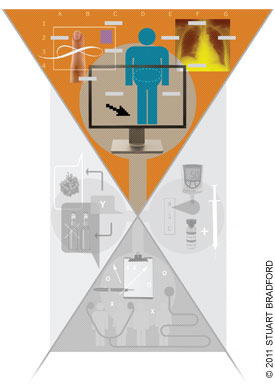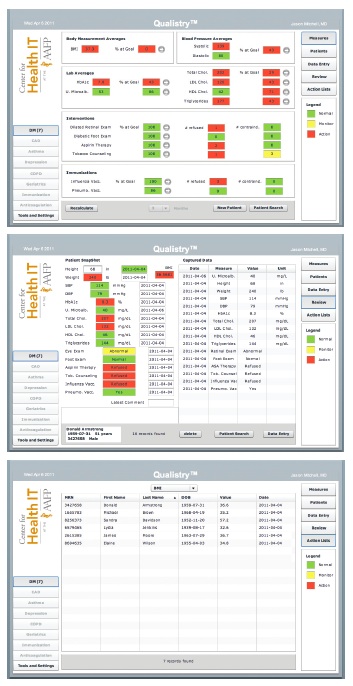
Organizing chronic illness care with a registry will streamline your workflow, improve patient outcomes and provide data for quality improvement.
Fam Pract Manag. 2011;18(3):11-14
Author disclosure: nothing to disclose.

A registry is basically a list of all the patients in your practice who have a particular condition. It helps keep track of when they were in to see you last, what tests they have had and what needs to be done to ensure they get all the recommended care. The office team can use the registry to organize the clinical information that you will need during the face-to-face visit with the patient, making it easier for you to know what is going on and what advice to give. They can also use the registry to track when to remind patients of needed care.
In the typical family medicine office, the conditions for which registries are most helpful include diabetes, asthma, coronary artery disease, hypertension, depression and possibly chronic obstructive pulmonary disease (COPD). For each of these conditions, the typical family physician will have a manageable number of patients, ranging from 10 to 20 patients for COPD to 150 to 200 patients for diabetes.
What's in it for me?
All registry programs have essentially the same functions. They collect and organize the clinical data for patients with a selected condition, present you with a snapshot at the time of the visit and allow your care team to ensure that the population of patients with that condition gets the care they need when they need it according to the best evidence. Using a registry will also help you appreciate the benefits of systematic care for a population of patients – the benefits of seeing patient care as a responsibility both to the individual and to the entire group. Most registries can also report out quality measures for health plans or the Centers for Medicare & Medicaid Services (CMS).
If your electronic health record (EHR) system does not have a registry function or you have yet to implement an EHR, stand-alone registry systems are available, and there are immediate advantages to modifying your clinical workflow and care team roles to incorporate registry use. You'll improve care now, and you'll make the transition to an integrated system easier in the future.
Your registry will ensure that, when you are seeing a patient in your office, you will have a single sheet of paper or a standardized computer screen that shows all the pertinent clinical parameters (see “Sample registry screens”). No more shuffling through the chart to find the date of the last lab test or eye exam; it will be right in front of you. Some registries flag entries that are out of range for the patient's condition (for example, an A1C greater than 7 percent). You will have more time to focus on management issues, educate patients and develop collaborative care plans. You'll be able to set up standing orders so that your staff can make sure that patients have had all needed tests or monitoring performed prior to the visit, eliminating call-backs after the visit. In time, you will know how many patients you are managing with a certain condition and whether you are meeting the management goals you set for your practice. This population management perspective allows you to evaluate and improve your overall care in a way that is not possible when you see information for just one patient at a time. (See “An Organized Approach to Chronic Disease Management” to learn how one group used a registry to spearhead quality improvement initiatives.)
Patients will appreciate the fact that you and your care team use a system to make sure everything gets done on a timely basis and important aspects of care are not delayed or forgotten. Patients like to go home with all their numbers. The individual report used for the patient visit can help keep patients engaged in their care and working to improve self-management. The registry can also support follow-up phone calls to patients about medication changes or treatment goals. Registries give you and your team the ability to manage patients proactively by letting you know if they have not been in for a visit or have missed a scheduled lab test.
Sample registry screens
The typical registry program can provide several useful views of the data it contains, including a snapshot of how the entire population of patients with a given disease is doing (top), a status screen for an individual patient (center) and a variety of "action lists" that can show just the patients who are out of range on any of a number of clinical measures (bottom). The screen shots are taken from Qualisty, a registry currently being developed by the Center for Health IT at the AAFP.

How do I get started?
You can view the process of developing a registry as having five steps.
1. View the video. To get everyone on the same page, gather your office staff and show the brief video on registries and how they work.
VIDEO
This video reviews the purpose, functions and benefits of a patient registry and gives advice on getting started.
2. Select a registry system. A registry may take a variety of forms, ranging from a homemade electronic spreadsheet or database to an interactive online product or an integrated component of an EHR. The more sophisticated the registry, the more likely it will be to produce reports useful in patient care and quality improvement.
Many registry systems are free, but there may be costs involved in using some commercial registry products. If you are using an EHR, check with your vendor to see if a registry function is available for your system. If your EHR has registry features that you can begin to use, fine. Otherwise, select and install one of the programs suggested in the resources box.
3. Populate your list. You may want to jump-start your registry initiative by having a staff member print out a list of all patients who have been billed for services involving certain ICD-9 codes in the past one or two years (e.g., 250.xx for diabetes) and add those patients to the registry. Once that's done, you can establish procedures for anyone on the care team to add, modify and remove registry records as appropriate.
4. Add data as patients are seen. While you may want to have staff pull charts to complete the registry data collection, this is not absolutely necessary. Having the care team add data as patients come in works perfectly well and makes data collection a by-product of care rather than a separate task. Have your team print out the patient status sheets for patients with upcoming visits and start using them to organize and collect data as patients are seen and to remind you of needed interventions. For instance, when a new patient with diabetes comes in for a visit, the nurse or medical assistant could start a record for him or her before you see the patient and print out a patient status sheet summarizing available information and highlighting areas where data are missing. After each visit, a copy of the updated patient status sheet can then be set aside for entry into the registry at an appropriate time.
Although you might like to hold off implementing a registry until essential data can be added to the registry automatically, it is likely to be a while before that capability becomes widespread. You'll want to develop a systematic way to collect the clinical information you need and have one of your team members add it to the registry regularly. Data entry and registry management is not a full-time job; it may only take a couple of hours per week. You and your staff are actually doing most of this work already but less efficiently. Even staff who normally do billing and posting can help with registry data entry.
In time, all EHRs will have embedded registry functions with some degree of automated data capture. Until then, use a simple registry system and redesign your work flow and team responsibilities to take advantage of this essential clinical information tool.
5. Use the registry to organize care. Although it takes some work to get the registry up and running, you will be rewarded with an organized presentation of critical clinical information as you are seeing the patient, and your staff will be better able to alert patients to needed care. As time goes on, your registry will fill with data and become more useful. Moreover, you'll find that the registry frees you to focus more on physician-level work.
BUILDING A REGISTRY IN 5 EASY STEPS
The article expands on this pathway to registry use:
Show the registry video to office staff.
Select a registry product that gives you easy computer access to the data.
Populate your list from practice management software.
Have the care team enter clinical data when patients are seen.
Use the registry to optimize care and identify patients who need services.
Registries and the PQRS
In 2007, Medicare initiated the Physician Quality Reporting Initiative, now called the Physician Quality Reporting System (PQRS), a program to pay physicians a bonus for reporting quality measures along with the billing codes for Medicare patients. This system was cumbersome and did not lend itself to quality improvement in office practice. In 2008, to simplify data collection, Medicare allowed physicians to use a registry to report their data to the PQRS. For 2011, the bonus is 1 percent of the physician's Medicare fees.
The bottom line
Registries are a simple way to organize your patient care, engage your staff and achieve better results for patients. The work needed to set up a registry will soon pay off with more efficient, more effective care for your patients with chronic illnesses.
